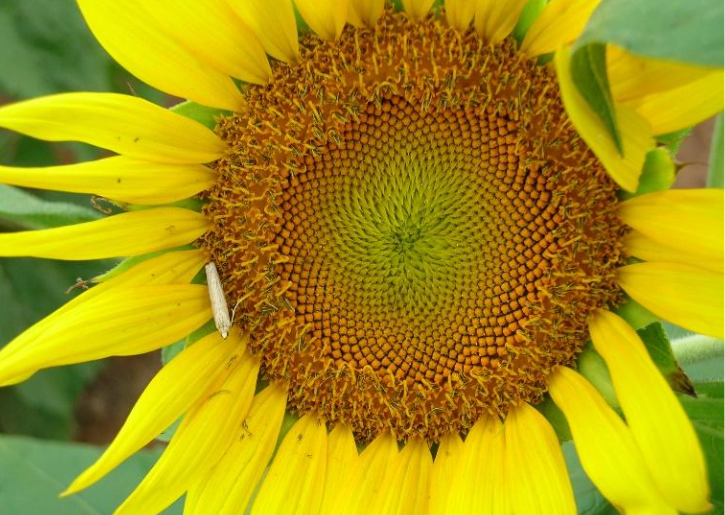Insecticide Application Timing for Red Sunflower Seed Weevil
This page was adapted from the article, "Insecticide Application Timing for Red Sunflower Seed Weevil," which appeared in Crop & Pest Report on August 4, 2022.
IPM scouts observed low number of red sunflower seed weevils, an average of 1 weevil per head, in sunflower buds this past week in central and southeastern ND (see map below). Sunflowers were planted later this year, from early to mid-June. Most sunflower fields are still in the late vegetative to R3 (bud >1 inch from leaf) crop stages. Routine weevil scouting should start in the late R4 through the R5.7 (late flowering) stages. With hot temperatures, sunflowers can move quickly through the susceptible flowering stages, reducing flowering time to less than 7-10 days.
When is the best timing for insecticide applications for seed-infesting insect pests like red sunflower seed weevil? Sunflower plant stage is critical when timing an insecticide application. Both bloom and flowering describe the sunflower plant when yellow ray petals are showing and pollen is being shed. It is important to distinguish between the percentage of the field in bloom from the percentage of individual plants in bloom. A field with 50 percent of the plants in bloom indicates that half of the plants are shedding pollen and the other half of the plants are in the bud stage. However, the individual plants in bloom will probably not all be at the same stage of bloom. Some plants may have just started to shed pollen (R5.1) and others may be at the end of pollen shed (R5.9). A plant in the 40 percent bloom stage would have 40 percent of the head shedding pollen (R5.4). This would be a ring of opened florets comprising about 25 percent of the head radius. The remaining 75 percent of the florets would be unopened.

The ideal plant stage to treat for red sunflower seed weevils is when most plants in the field are at 40 percent pollen shed (R5.4). However, we recommend that treatment be considered when more than 50% of the plants in the field are just beginning to show yellow ray petals (R5.0) to 30 percent of the head shedding pollen (R5.3) and the rest of the plants in the field are still in the bud stage. This difference between the ideal plant stage (R5.4) to treat and the earlier plant stage (just beginning pollen shed, R5.1) is based, in part, on the fact that aerial applicators have a busy schedule, and may not be able to spray on time due to adverse weather. Treating at the early bloom stage should allow growers a sufficient buffer of time to have their fields treated at the proper time. Growers must be aware, however, that if weevil populations are high and/or spraying is done too early, a re-infestation may occur and a second insecticide application may be necessary.
Although insecticides applied to sunflower at the bud stage will kill weevils, treatments at that stage are not economical or effective because (1) seeds have not developed to a stage suitable for oviposition, (2) eggs within the female weevil are not mature, and (3) adult weevil emergence is still continuing. Sunflower normally reaches the bud stage in late July at which time only about 30 percent of the weevils in the soil have pupated and emerged. Most weevils emerge from the soil by the first week of August. If growers were to spray bud stage sunflower in mid to late July, a second spray may be necessary as more weevils continue to emerge.
Due to poor performance and reported field failures with pyrethroid insecticides for control of red sunflower seed weevils over the past years, especially in South Dakota (NSA funded research – Drs. Varenhorst and Knodel), we are recommending that sunflower growers use the high labeled rate of their selected insecticide to mitigate further insecticide failure issues. With chlorpyriphos (Lorsban and generics) no longer available for use on any field crops, sunflower growers only have one option for red sunflower seed weevil control – the pyrethroid (3A) insecticides. Based on research data, we recommend caution when using lambda-cyhalothrin (Warrior II and generics) and zeta-cypermethrin (Mustang Max) since 71% and 83% of the fields sampled in SD were found to have reduced susceptibility for weevil control in 2021, respectively. This may be due in part to the effects of high temperature on pyrethroid insecticides. Temperatures above 90⁰F can shorten the residual activity of pyrethroids. Lambda-cyhalothrin and zeta-cypermethrin are more sensitive to high temperatures than esfenvalerate (Asana XL). Although carbaryl (Sevin XLR Plus) is registered in sunflowers, red sunflower seed weevil is not listed on the label and the label states that applications are not allowed on any flowering crop due to high toxicity to bees. We are continuing to test red sunflower seed weevil populations in SD and ND to further examine the pyrethroid insecticide efficacy. Thanks to the National Sunflower Association for funding.
Chlorpyrifos Alternatives for RSSW
- Pyrethroids
- 3A - beta-cyfluthrin (Baythroid XL)
- cyfluthrin (Tombstone)
- deltamethrin (Delta Gold)
- esfenvalerate (Asana XL)
- lamba-cyhalothrin (Warrior II, generics)
- zeta-cypermethrin (Mustang Maxx)
Disclaimer: Mention of any insecticides does not imply endorsement of one product versus another nor discrimination against any product not mentioned by the authors or universities.
